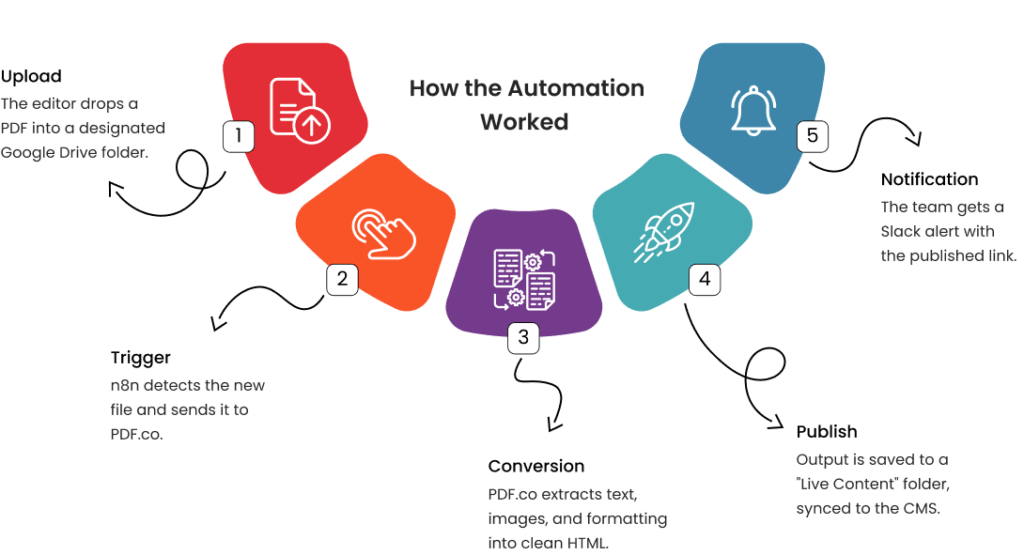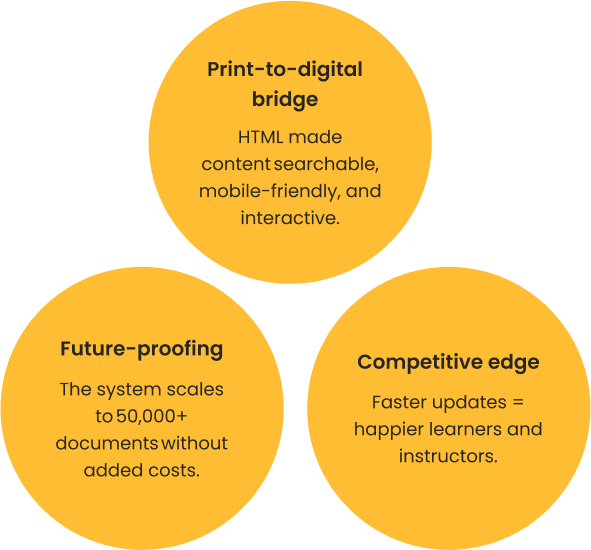n8n Automation: PDF-to-HTML Webpage Conversion
Industry: [CATEGORY]
Client Introduction: A Leading French E-Learning Publisher.
Tools and Technologies:

The story of how we built a zero-touch publishing pipeline that saved 200+ hours/month
The client is a top-tier educational publisher based in France that has built a reputation for excellence in print textbooks over several decades. With the rapid growth of digital learning, they recognized the need to transition their extensive library of print materials into web-friendly formats. Their catalog included thousands of PDFs — ranging from textbooks to instructor guides — that needed to be converted into clean, responsive HTML for integration into their e-learning platforms.
Despite their content’s high quality, the conversion process was fraught with inefficiencies and high costs. Each PDF required manual intervention from web developers, who painstakingly extracted text, reformatted layouts and ensured compatibility with web standards. This process took three to five days per document, creating bottlenecks that delayed course launches and frustrated both content teams and learners. The publisher needed a solution to eliminate manual work, reduce errors and accelerate their digital publishing pipeline.
Manual Processes and Growing Pains
The publisher faced several critical pain points in their existing workflow. First, the sheer volume of documents made manual conversion unsustainable and very costly. Their web development team, which should have been focused on enhancing the e-learning platform’s features, spent nearly a third of their time on repetitive formatting tasks instead.
Second, human errors were inevitable. Even minor mistakes in HTML tagging or CSS styling could disrupt the readability of content, requiring additional rounds of revisions. These errors not only wasted time but also risked the publisher’s reputation for accuracy and professionalism.
We were wasting hundreds of hours just moving content from one format to another—time we should have spent innovating. — Client’s CTO
Finally, the manual process simply couldn’t scale. As demand for digital content grew, the publisher needed to convert hundreds of documents monthly — a target far beyond their web development team’s capacity. Without automation, they risked falling behind competitors who could deliver content faster and more efficiently.
While their content was high-quality, their publishing process was stuck in the past:
Breaking Down the Bottlenecks
| Issue | Impact |
|---|---|
| Slow conversions | Delays in course launches by 2-3 weeks per project |
| Developer dependency | The tech team spent 30% of their time on PDF formatting |
| Human errors | 15% of files needed rework due to broken HTML/CSS |
| Scalability limits | Could only process ~20 PDFs/month (vs. 200+ needed) |
A Fully Automated Conversion Pipeline
To address these challenges, we designed an end-to-end automated workflow using three core technologies: n8n for orchestration, PDF.co for document conversion, and Google Drive for secure file management.
The process began when an editor uploaded a PDF to a designated Google Drive folder. This action triggered an n8n workflow, which routed the file to PDF.co for conversion. PDF.co’s advanced engine preserved the document’s structure—including complex elements like equations, tables, and images—and generated clean, web-optimized HTML. The converted file was then saved back to Google Drive in a folder linked directly to the publisher’s content management system (CMS).
The key innovation was the seamless integration between these tools. From the moment a PDF was uploaded, the system handled every step without human intervention. The HTML output was instantly available on the live website, and the content team received an automated notification confirming publication.
Tech Stack Breakdown
| Tool | Role | Why It Was Chosen |
|---|---|---|
| n8n | Workflow automation | Open-source, flexible, and EU-hostable |
| PDF.co | PDF-to-HTML conversion | Handles complex layouts with 95%+ accuracy |
| Google Drive | Secure storage & trigger | Already in the client’s ecosystem |

Results: From 5 Days to 5 Minutes Per Document
The new system delivered transformative results. Where manual conversions once took days, the automated pipeline reduced processing time to mere minutes. Over a month, this saved the publisher more than 200 hours of developer time—resources that were redirected toward higher-value projects, such as improving the platform’s user experience.
Error rates plummeted from 15% to under 2%, ensuring consistent quality across all published materials. The publisher could now scale their operations effortlessly, processing hundreds of documents monthly without adding staff. Most importantly, they accelerated their time-to-market for new courses, strengthening their position in the competitive e-learning industry.
Quantifiable Impact
200+ hours/month saved in developer time
90% faster content publishing (now ~5 minutes per PDF)
Error rate dropped from 15% to <2%
ROI achieved in 3 months (from dev cost savings alone)
Strategic Benefits
Why This Matters for All E-Learning Publishers ?


Security and Compliance Considerations
Given the publisher’s strict data governance requirements, security was a top priority. All files were processed through encrypted HTTPS connections, and no sensitive data was retained by third-party services. Google Drive’s access controls ensured that only authorized personnel could interact with the system, while PDF.co’s EU-based servers guaranteed compliance with GDPR and French data protection laws.
A Foundation for Future Growth
This business process automation project did more than streamline a single process—it empowered the publisher to embrace digital transformation fully. They unlocked new agility, allowing their teams to focus on innovation rather than repetitive tasks by eliminating manual bottlenecks. Today, their e-learning platform grows dynamically, with content updates happening in real-time and their developers are free to build features that enhance the learning experience.
For organizations facing similar challenges, this case study demonstrates the power of workflow automation. With the right tools and strategy, even the most labor-intensive processes can be transformed into efficient, scalable systems.
The client didn’t just save time !
They reinvented their content lifecycle. Today, their e-learning library grows seamlessly and their team focuses on innovation, not busy work.
I’m Ready to Transform My Publishing Workflow
Testimonials: Hear It Straight From Our Customers
Our development processes delivers dynamic solutions to tackle business challenges, optimize costs, and drive digital transformation. Expert-backed solutions enhance client retention and online presence, with proven success stories highlighting real-world problem-solving through innovative applications. Our esteemed clients just experienced it.















